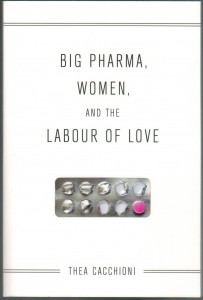In 2020 the last of the big Pfizer Inc. patents on Viagra will expire in the U.S. and the retail price of the little blue pills will collapse from $25 to mere pennies. Viagra revenues in the U.S. have averaged $2 billion a year. What is industry to do? “Disease mongering,” writes Thea Cacchioni, assistant professor at the University of Victoria.
In a damning exposé Cacchioni accuses pharmaceutical companies of a feverish search for unproven cures for a dubious “illness”, FSD: female sexual dysfunction. Big Pharma is a no-nonsense account of the campaign for a “pink Viagra”.
Viagra was one of the great chemical moneymakers of all time. Faced with the inevitable loss of patents – Viagra rights have already expired in the European Union and Canada – the clock is ticking: “Big Pharma has dedicated millions of dollars to the search for a sexual enhancement drug for women,” Cacchioni writes. “Viagra has not been a panacea for the vast majority of men’s sexual problems, and its risks have turned out to be much greater than Pfizer Inc. would have us believe – including loss of eyesight and increased rate of heart attacks. Yet the drug industry has gone to great lengths to cash in on the estimated US $1.7 billion market for sex drugs for women.”
Dr. Cacchioni is not a chemist but a sociologist. She has organized conferences on women’s sexuality, and testified at public hearings of the U.S. Food & Drug Administration on the phenomenon of chemical “cures” for phantom diseases like FSD – the kind of hearings that don’t occur at Health Canada.
Take Flibanserin, approved only last week by U.S. regulators as treatment for “hypoactive sexual desire disorder” in women. Cacchioni concludes that clinical trials were subjective; many women who took the drug complained of insomnia, fatigue, dizziness and nausea; and it isn’t obvious any drug is necessary in the first place. The campaign for pink Viagra reflects the “medicalization of sexuality,” she writes.
“Sexual medicine clearly emphasizes the bio, then the psycho, and rarely the social theorizations of sex and the body,” Big Pharma asserts; “Contrary to the drug industry and the medics it funds, sexual ‘shortcomings’ have not been eliminated by providing men a blue pill and women a pink one”; “Understanding sexual problems as simply the result of poor blood flow, hormonal imbalance or the short-circuiting of neurological hardwiring ignores key social, economic and political factors that shape sexual pleasure and displeasure.”
Most damning is the evidence most often cited by FSD proponents that a staggering 43 percent of women suffer from sexual dysfunction. The figure has been cited more than a thousand times, by Cacchioni’s count. Yet it is based on a single 1994 survey published in the Journal of the American Medical Association that asked women if they had experienced any sexual difficulties in the past year: “For example, if they lacked interest in sex, felt anxious about their sexual performance, had trouble with lubrication, failed to orgasm, came too quickly, or experienced pain during intercourse.”
Any number of factors might account for those symptoms: kids, the economy, Visa bills, you name it. “The 43 percent statistic came from assuming that an answer of ‘yes’ to any one of those questions was grounds for categorizing the respondent as having FSD”. Oh, and two of the authors of the survey had financial ties to Pfizer.
Big Pharma is smart and crisp, and of compelling interest to every Canadian interested in sex or money – so, pretty much everybody.
By Holly Doan
Big Pharma, Women and the Labour of Love by Thea Cacchioni; University of Toronto Press; 152 pages; ISBN 9781-4426-11375; $21.95






